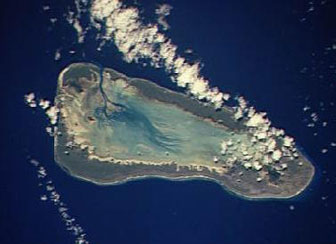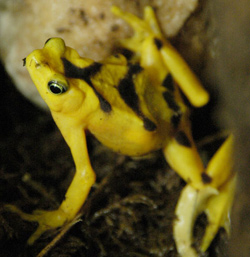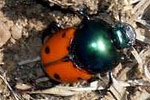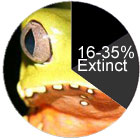- The Aldabra banded snail (Rachistia aldabrae), a rare and poorly known species found only on Aldabra atoll in the Indian Ocean, has apparently gone extinct due to declining rainfall in its niche habitat.
- While some may question lamenting the loss of a lowly algae-feeding gastropod on some unheard of chain of tropical islands, its unheralded passing is nevertheless important for the simple reason that Rachistia aldabrae may be a pioneer.
- As climate change increasingly brings local and regional shifts in precipitation and temperature, other species are expected to follow in its path.
Goodbye to a snail.
The Aldabra banded snail (Rachistia aldabrae), a rare and poorly known species found only on Aldabra atoll in the Indian Ocean, has apparently gone extinct due to declining rainfall in its niche habitat. While some may question lamenting the loss of a lowly algae-feeding gastropod on some unheard of chain of tropical islands, its unheralded passing is nevertheless important for the simple reason that Rachistia aldabrae may be a pioneer. As climate change increasingly brings local and regional shifts in precipitation and temperature, other species are expected to follow in its path.
Perhaps unsurprisingly for an inconspicuous snail living on an atoll 426 kilometers northwest of the northern tip of Madagascar and 1150 kilometers southwest of Mahé, the principal island of the Seychelles, the life history of the Aldabra banded snail is a mystery. What is known, is that since the late 1990s, extensive surveys of the Aldabran islands of Picard, Malabar, Polymnie, Esprit and Grande Terre have failed to turn up any Rachistia aldabrae individuals. The only remains of the species, last seen alive a decade ago, are scattered indigo blue and orange shells in the “mixed scrub” of Aldabra.
Unlike more charismatic species — the dodo, giant elephant bird, Tasmanian Tiger, the Baiji, or Bali tiger — that have made their exits, the demise of the Aldabra banded snail resulted not from overexploitation, destruction of habitat, introduction of alien species, accidental catch, or hunting, but from subtle changes in its environment.

NASA Astronaut Image of Aldabra Atoll (Seychelles) in the Indian Ocean. Aldabra Atoll, designated a World Heritage Site, is home to the world’s largest population of giant tortoises and the Aldabra rail, the last surviving flightless bird of the Indian Ocean region. Image courtesy of the Image Science & Analysis Laboratory, NASA Johnson Space Center. |
Justin Gerlach, an Oxford University biologist with the Nature Protection Trust of Seychelles who has just authored the definitive paper on the extinction of Rachistia aldabrae, postulates that recent declines in rainfall spelled the end for the snail, which hibernates during dry periods.
“Decreases in rainfall would have reduced the length of activity periods,” he writes in the current issue of the journal Biology Letters. “This may not have been a major additional cause of mortality to adults, but the small juveniles would be less able to tolerate the desiccation. Consequently, long dry periods would be expected to reduce reproductive success, with complete failure in prolonged dry periods.”
Evidence, says Gerlach, comes from shell fragments. It seems that all shells collected since 2000 belong to adult individuals.
“From this, it seems probable that decreasing rainfall over 1980s and 1990s led to high juvenile mortality, and consequently an ageing population.”
Aging, he says, “may have led to the complete extinction of all populations between 1997 and 2000.”
The Aldabra banded snail’s extinction without direct interference from predators or mankind, make it a special occurrence, but one that is expected to become less rare in the future.
“This may be one of the few cases of extinction that cannot be attributed to a change in habitat, predators or diet, but may plausibly result from the direct impacts of climate on survival,” explains Gerlach. “Climate change has been proposed as a factor leading to the decline of many species, either directly or through indirect associations… There are few cases where this has been demonstrated directly (the golden toad Bufo periglenes), although indirect effects are reported for a large number of amphibian species.”
 Panama’s golden frog (Atelopus zetecki) is highly threatened by the killer chytrid fungus (Batrachochytrium dendrobatidis), an infectious skin disease now found in frog populations around the world. In 2006, Dr. Alan Pounds and colleagues published a study which found that almost two-thirds of the 110 known harlequin Atelopus toad species of Central and South America went extinct in the 1980s and 1990s. The leading culprit for the demise was a type of chytrid fungus (Batrachochytrium dendrobatidis), an infectious skin disease. The researchers discovered strong correlations between changes in climate and the last known sightings of the frogs. According to the scientists, the Earth’s rising temperatures enhance cloud cover on tropical mountains, leading to cooler days and warmer nights, both of which favor the chytrid fungus which grows and reproduces best at temperatures between 63 to 77 degrees Fahrenheit (17 to 25 degrees Celsius). |
Lately amphibians, especially brightly colored frogs and toads, have become the poster species for climate change-linked extinction. While scientists are just beginning to understand the rapid worldwide decline in amphibians, climate change is increasingly tied to shifts in habitats and the outbreak of a deadly fungal disease, which is killing frogs, toads, salamanders, newts, and caecilians on every continent. To date, more than 170 species are thought to have gone extinct since 1980 while the Global Amphibian Assessment, a comprehensive status assessment of the world’s amphibian species, classifies one-third of the world’s 5,918 known amphibian species as threatened with extinction. Some scientists believe that amphibians may just be the proverbial “canary in the coal mine” — the first group of animals to go before a wider die-off begins.
This trend among amphibians suggest that the Aldabra banded snail will not go alone. Thousands of species will join it, leaving Earth a poorer place.
Ironically even if drought had not done in the Rachistia aldabrae, its was likely doomed to extinction. With much of their elevation just inches about sea level, some islands in the Aldabra atoll are likely to become some of the first places inundated by rising sea levels. The culprit? Also climate change.
CITATION: Justin Gerlach (2007). Short-term climate change and the extinction of the snail Rachistia aldabrae (Gastropoda: Pulmonata). Biology Letters doi:10.1098/rsbl.2007.0316
Related articles
 |
Biodiversity extinction crisis looms says renowned biologist
(3/12/2007) While there is considerable debate over the scale at which biodiversity extinction is occurring, there is little doubt we are presently in an age where species loss is well above the established biological norm. Extinction has certainly occurred in the past, and in fact, it is the fate of all species, but today the rate appears to be at least 100 times the background rate of one species per million per year and may be headed towards a magnitude thousands of times greater. Few people know more about extinction than Dr. Peter Raven, director of the Missouri Botanical Garden. He is the author of hundreds of scientific papers and books, and has an encyclopedic list of achievements and accolades from a lifetime of biological research. These make him one of the world’s preeminent biodiversity experts. He is also extremely worried about the present biodiversity crisis, one that has been termed the sixth great extinction.
Extinction, like climate change, is complicated
(3/26/2007) Extinction is a hotly debated, but poorly understood topic in science. The same goes for climate change. When scientists try to forecast the impact of global change on future biodiversity levels, the results are contentious, to say the least. While some argue that species have managed to survive worse climate change in the past and that current threats to biodiversity are overstated, many biologists say the impacts of climate change and resulting shifts in rainfall, temperature, sea levels, ecosystem composition, and food availability will have significant effects on global species richness.
 |
Deforestation causes species extinction in Madagascar
(3/7/2007) Deforestation has already caused the extinction of a large number of endemic insect species on the island of Madagascar, according to new research published in the March edition of the journal Biology Letters. The work suggests that only half the species confined to these forest areas will survive.
 |
Neon green gecko key to preventing Mauritian plant extinction
(4/17/2007) A vibrantly colored gecko plays a key role in a highly threatened ecological community in Mauritius reports new research published in American Naturalist. Studying plant-animal interactions in Mauritius, an Indian Ocean island famous for its extinct dodo bird, researchers found that a rare plant, Trochetia blackburniana, benefits from its proximity to Pandanus plants because they house high densities of geckos responsible for pollination. The findings, which unusually identify a lizard as a key pollinator, are significant because they provide “valuable management insights for ongoing conservation efforts to save the highly endangered flora of Mauritius.
 |
Just how bad is the biodiversity extinction crisis?
(2/6/2007) In recent years, scientists have warned of a looming biodiversity extinction crisis, one that will rival or exceed the five historic mass extinctions that occurred millions of years ago. Unlike these past extinctions, which were variously the result of catastrophic climate change, extraterrestrial collisions, atmospheric poisoning, and hyperactive volcanism, the current extinction event is one of our own making, fueled mainly by habitat destruction and, to a lesser extent, over-exploitation of certain species. While few scientists doubt species extinction is occurring, the degree to which it will occur in the future has long been subject of debate in conservation literature. Looking solely at species loss resulting from tropical deforestation, some researchers have forecast extinction rates as high as 75 percent. Now a new paper, published in Biotropica, argues that the most dire of these projections may be overstated. Using models that show lower rates of forest loss based on slowing population growth and other factors, Joseph Wright from the Smithsonian Tropical Research Institute in Panama and Helene Muller-Landau from the University of Minnesota say that species loss may be more moderate than the commonly cited figures. While some scientists have criticized their work as “overly optimistic,” prominent biologists say that their research has ignited an important discussion and raises fundamental questions about future conservation priorities and research efforts. This could ultimately result in more effective strategies for conserving biological diversity, they say.